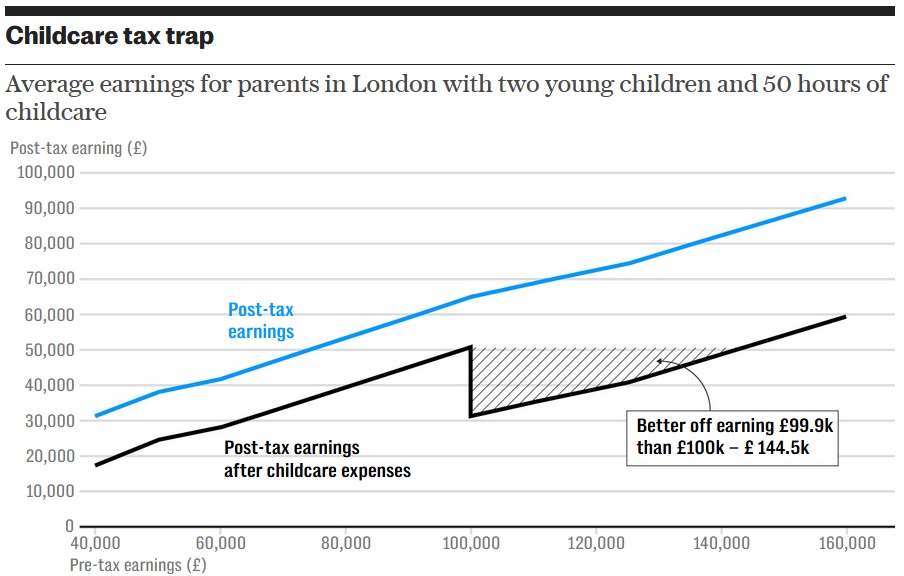When trying to educate someone about the importance of low marginal tax rates, what’s the most-convincing visual?
- A supply-and-demand graph?
- A philoso-raptor meme?
- A cartoon with two doors?
- A Dan Mitchell hypothetical?
I’m partial to the image I created, of course, but let’s look at a real-world example that is very compelling.
In an article about Tory tax policy for the U.K.-based Telegraph, Charlotte Gifford included a graph showing that a family with two children can have more disposable income with an income of £99,000 rather than an income of £144,000.
In other words, there’s a de facto 100 percent tax rate on the additional £45,000.
At the risk of understatement, there’s not much incentive to earn more income if the government imposes a de facto 100 percent tax rate.
That’s the kind of policy you expect to see in France, not the United Kingdom.
So why is it happening? Ms. Gifford explains.
High-earning parents are better off only working four days a week as bizarre tax rules mean it no longer pays to work. …One of the biggest distortions in the tax system occurs once a parent earns more than £100,000. …One reader told The Telegraph they were considering shortening their working week from five days to four after realising they would keep more of their pay by earning £92,000 as opposed to £115,000. Reducing the working week makes perfect financial sense for many parents earning £100,000 or more. By working fewer days they would not only dodge the tax trap but also cut their childcare costs, which currently average at £285 per week full-time, or £13,695 a year.
If you want details, the de facto 100 percent-plus tax rate is the combined result of three factors.
- A statutory tax rate of 40 percent.
- The government’s clawback of the value of the personal allowance, pushing the effective marginal tax rate up to 60 percent. As stated in the article, “Once someone’s salary hits £100,000 they lose the personal allowance at a rate of £1 for every £2 until it disappears at £125,140.”
- The loss of a government handout. As Ms. Gifford wrote, “…once a parent earns more than £100,000…they lose their entitlement to free childcare… This creates a perverse incentive for parents earning £99,000 to turn down a pay rise so they can hold on to the government benefit.”
The moral of the story is that people respond to incentives.
When the government makes it less attractive for people to be more productive and earn more income, they respond by…drum roll, please…being less productive and not earning more income.
Which means less taxable income for the government (hello, Laffer Curve).
That’s the simple lesson of supply-side economics.
P.S. American readers should know that there are also examples of implicit 100 percent-plus effective marginal tax rates in the United States.
P.P.S. The United Kingdom has bad tax policy because it has bad spending policy.
P.P.P.S. To avoid these problems, nations should have flat taxes and limited government.

No comments:
Post a Comment